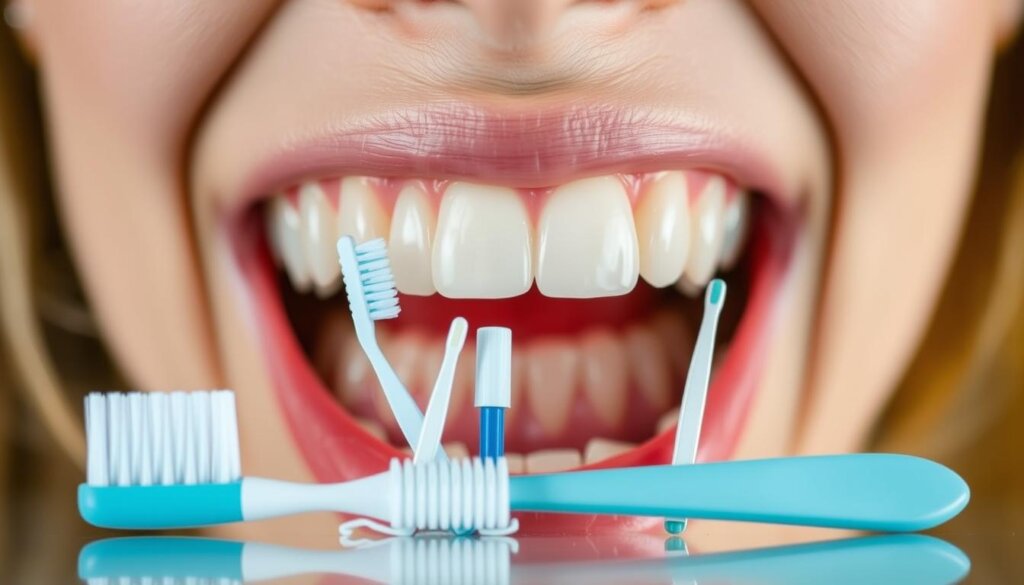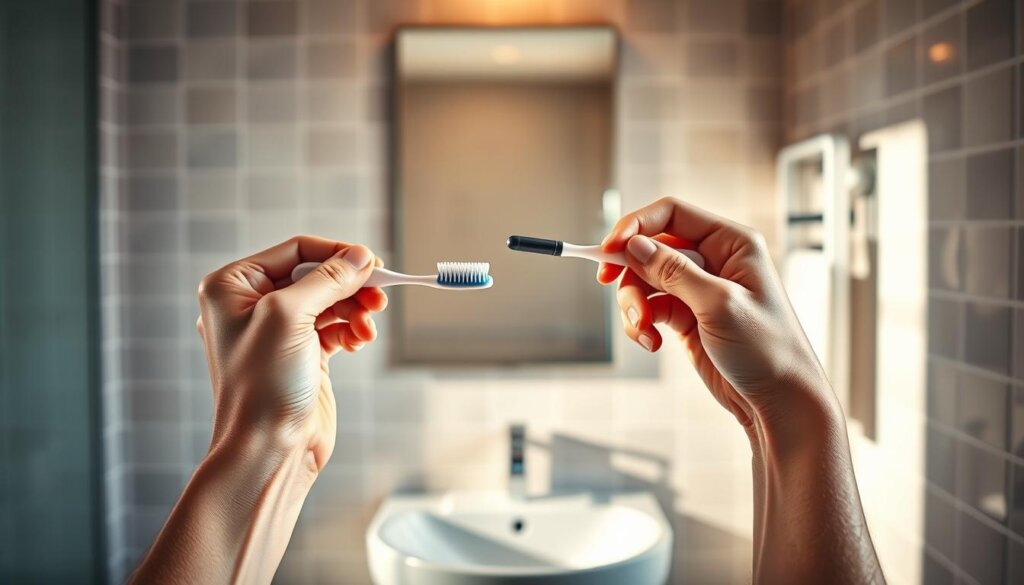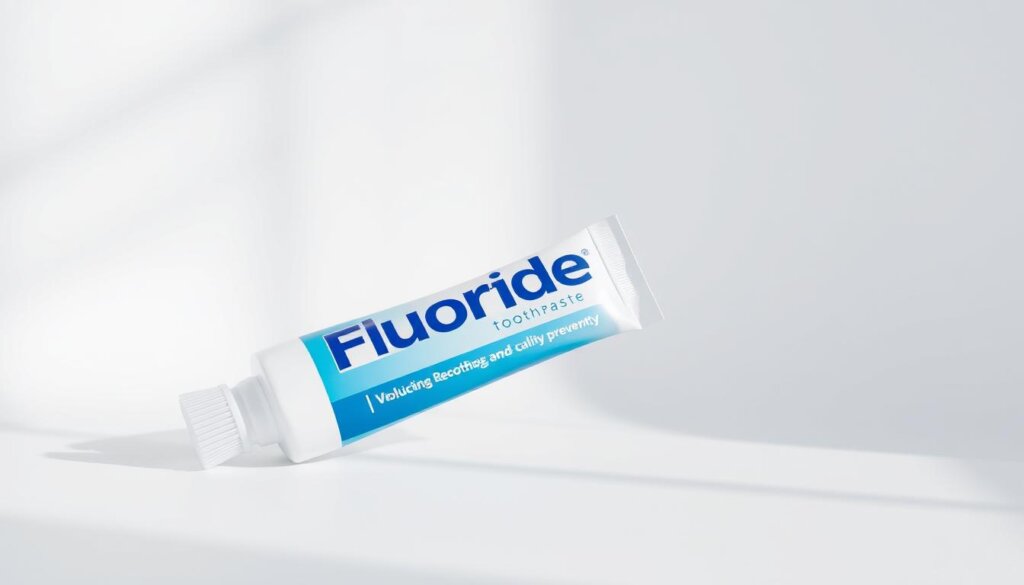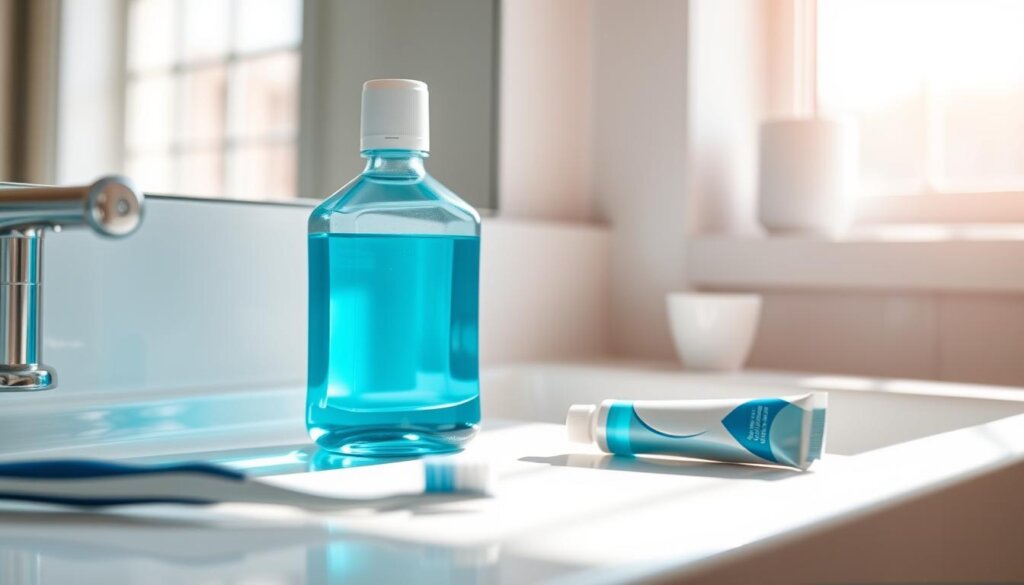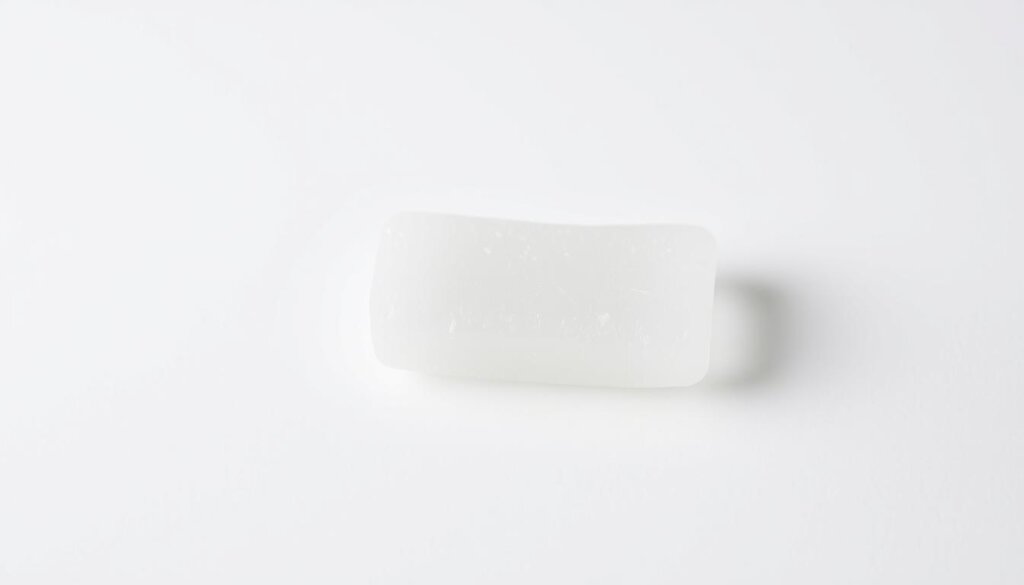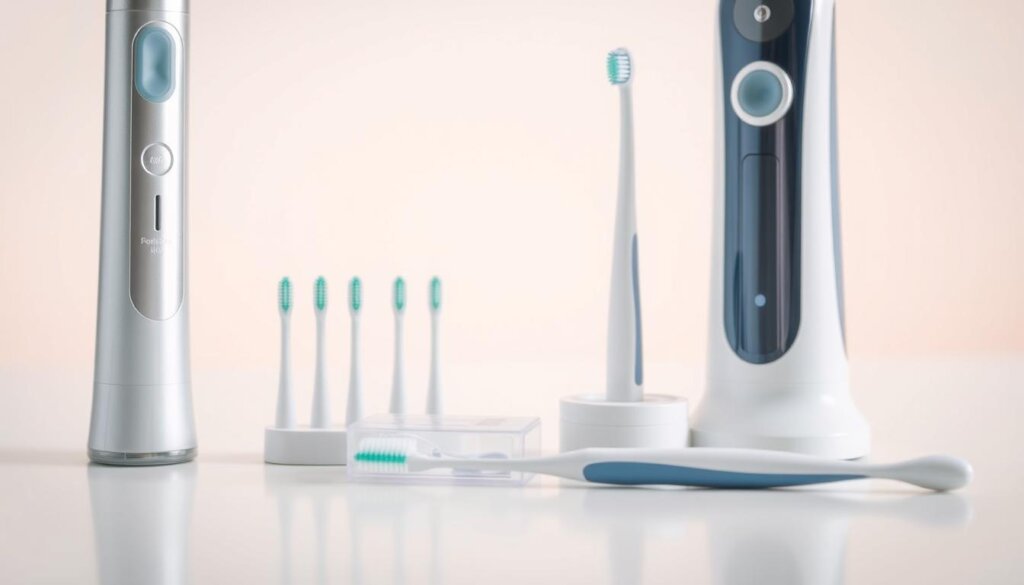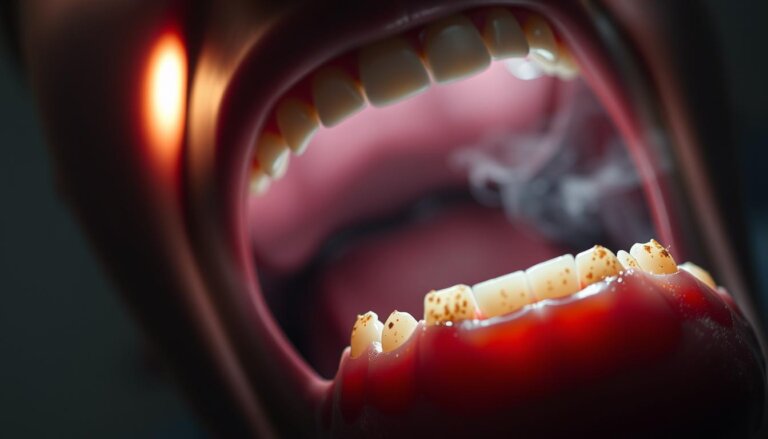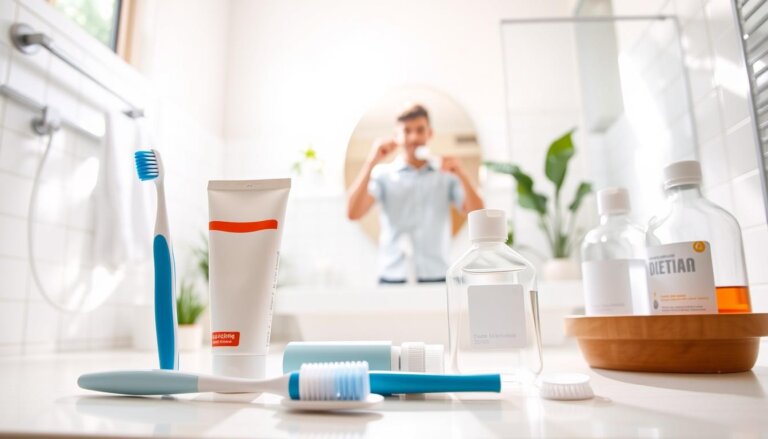How Can I Keep My Teeth Clean Between Dental Visits?
Even though they know it’s important, 25% of adults don’t brush their teeth two times a day. This increases their risk of getting cavities by 33%, says the American Dental Association. It’s clear there’s a big gap between knowing what to do for our teeth and actually doing it. To keep our smiles bright and our mouths healthy, adding daily dental care tips to our habits is vital. The Cleveland Clinic says that taking care of our teeth every day is essential for preventing issues and keeping our teeth healthy.
To avoid dental problems, it’s not enough to just brush and floss. There’s a right way to do it that keeps your teeth healthy between dentist visits. The aim is to stop common teeth troubles and to keep our mouths healthy for a long time. Talking to a dentist and making a plan that fits our needs makes sure we take the best care of our teeth. This way, we can keep our teeth in top shape with regular care.
Key Takeaways
- Brushing twice a day is essential for dental health, yet many adults fall short of this practice.
- Proper dental hygiene tips can reduce the risk of dental decay significantly.
- Personalized oral health care routines developed with a dental professional can provide tailored benefits.
- Best practices for oral hygiene go beyond brushing and flossing to include lifestyle and dietary adjustments.
- Consistency in an oral health care routine is key to maintaining dental health between visits.
Understand the Importance of Dental Hygiene
Having healthy teeth and gums is more than just looking good. It is essential for your overall health. Daily dental care habits prevent problems and keep teeth and gums working well. Knowing how good dental hygiene helps you can lead to better care routines.
Benefits of regular dental care
- Prevents the buildup of plaque, reducing the risk of tooth decay and gum disease.
- Supports the maintenance of a clear, confident smile which enhances social interactions and self-esteem.
- Helps in the prevention of more severe health issues related to poor oral health, such as heart disease and diabetes.
Consequences of neglecting oral health
- Increased risk of developing cavities, gum diseases like gingivitis and periodontitis, which could lead to tooth loss.
- Persistent bad breath and a decline in overall mouth cleanliness can impact one’s personal and professional life.
- Financial burden from the need for more extensive dental treatments that might have been preventable with regular care.
| Aspect of Dental Health | Impact of Regular Care | Impact of Neglect |
|---|---|---|
| Teeth | Remains strong, less cavities | Higher chance of decay and loss |
| Gums | Healthy, no bleeding or swelling | Risks of infection and diseases |
| Overall Health | Reduced risk of related diseases | Increased risk of systemic issues |
Daily Brushing Techniques for Optimal Cleanliness
Keeping your teeth clean is key for good dental visit preparation and oral hygiene maintenance. It’s important to clean your teeth well between dentist visits. This guide focuses on basic brushing methods that help keep your teeth healthy and avoid problems.
Best Practices for Effective Brushing
Start with the right brushing technique for healthy teeth. Using fluoride toothpaste is a must. It strengthens the enamel and fights off decay. Hold the brush at an angle towards the gum and brush gently in a circular motion. This cleans every side of your teeth. Don’t forget to brush your tongue too. It keeps your breath fresh by removing bacteria.
Choosing the Right Toothbrush
Choosing the best toothbrush is a big part of oral care. Your toothbrush should fit well in your mouth and hand. This makes brushing every part easy. Pick a toothbrush with soft bristles. They’re kind on your gums and good at removing plaque, keeping your gums healthy.
Change your toothbrush every three to four months, or sooner if the bristles are worn out. The advice here aims to improve your daily teeth cleaning routine. By following these suggestions, your teeth and gums will be healthy until your next dentist appointment.
Selecting the Right Toothpaste
Finding the right toothpaste is key for keeping your mouth healthy. It works alongside brushing to deliver important agents that fight dental diseases.
Fluoride is the main thing to look for in toothpaste. It’s proven to fight tooth decay and make enamel stronger. If you follow good oral hygiene rules, fluoride toothpaste is usually suggested to help prevent cavities.
Essential Ingredients to Look For
- Fluoride: Key in preventing tooth decay and enhancing enamel repair.
- Calcium phosphate: Contributes to the remineralization of the teeth.
- Sodium lauryl sulfate: Helps in plaque removal and creates foam to clean teeth more effectively.
Fluoride vs. Non-Fluoride Toothpaste
Fluoride is favored for its decay-fighting qualities. Yet, there’s non-fluoride toothpaste for those with allergies or who prefer holistic options. These kinds often have natural ingredients like herbal extracts and essential oils to maintain oral hygiene.
| Ingredient | Benefits | Recommended For |
|---|---|---|
| Fluoride | Prevents tooth decay, strengthens enamel | Most adults and children |
| Herbal Extracts | Natural anti-inflammatory properties | Individuals seeking holistic alternatives |
To choose the best toothpaste, talk to a dentist. They can make sure it meets your specific oral health needs and good hygiene practices.
Flossing: An Essential Daily Habit
Flossing isn’t just about keeping your smile looking good; it’s a key part of keeping your mouth healthy. It gets rid of food particles and plaque where your toothbrush can’t reach. Making it a part of your daily dental care habits and oral hygiene maintenance is important.
When you floss, start with 18 to 24 inches of it. Wrap it around your fingers. Then, gently push it between your teeth to the gum line.
Curve the floss around each tooth in a C shape. Move it gently up and down for a good clean. This method cleans well without hurting your gums.
- Standard Nylon Floss: Great if your teeth have space between them. But, it can tear in tighter spots.
- Monofilament Floss: Made to not tear easily. It’s good for teeth that are close together.
- Dental Floss Picks: These are easy to use, especially if you find regular floss hard, like for people with arthritis.
- Water Flossers: These don’t use string but a water stream to clean. They’re a different way to floss, getting rid of food and plaque under the gum line and between teeth.
Picking the right floss is crucial for keeping your mouth clean. Based on what you need and like, there are many types of flossing tools to choose from. They can help improve your daily dental care habits and oral hygiene maintenance.
Mouthwash: The Importance of Rinsing
Adding mouthwash to your daily oral health routine can make a big difference. It cleans parts of your mouth that brushing and flossing might miss. This helps in reducing bacteria, promoting overall cleansing, and leaving your breath feeling fresh.
Mouthwash is key for keeping good oral hygiene. It can be a game-changer in your daily habits. Its use ensures your mouth feels clean and fresh all day.
Benefits of Using Mouthwash
- Reaches difficult-to-clean areas, supplementing brushing and flossing
- Helps reduce the level of harmful bacteria in the mouth
- Provides a fresh breath and a clean feeling
Alcohol-Free vs. Alcohol-Based Mouthwashes
Choosing the right mouthwash, alcohol-free or alcohol-based, depends on your needs and how sensitive your mouth is. Below are some things to think about:
| Feature | Alcohol-Free Mouthwash | Alcohol-Based Mouthwash |
|---|---|---|
| Suitability for Sensitive Mouths | More suitable, less irritation | May cause burning sensation |
| Drying Effect | Less drying, maintains moisture | Can be drying, not recommended for dry mouth conditions |
| Antibacterial Properties | Mild antibacterial properties | Strong antibacterial effects due to alcohol content |
When picking a type for your hygiene routine, think about your oral health and specific issues like sensitivity or dry mouth. If your mouth is more sensitive, alcohol-free mouthwash might be better. It’s gentler and less likely to make you uncomfortable.
Food Choices that Impact Dental Health
Diet plays a crucial role in maintaining healthy teeth and gums. Foods nourish us and impact our oral health. Making smart food choices helps you prepare for dental visits, leading to smoother check-ups.
To keep your mouth healthy, it’s key to eat good snacks and avoid bad ones. We’ll show you what foods to eat and what to avoid:
| Snacks to Promote Clean Teeth | Foods to Avoid for Better Oral Health |
|---|---|
| Crunchy fruits like apples | Sticky candies and sweets |
| Raw vegetables such as carrots | Carbonated soft drinks |
| Nuts | High-sugar sports drinks |
| Cheese and other dairy products | Alcoholic beverages that dry the mouth |
| Water-rich fruits like watermelon | Refined carbohydrates such as white bread |
Eating a balanced diet helps your overall and oral health. Crunchy fruits and veggies clean your teeth naturally. This can lower the chance of getting cavities.
Avoiding sugary and acidic foods is also key. They can cause bacteria and acid to grow, harming your teeth and gums. Good eating habits are important for dental visit preparation. They keep your appointments problem-free.
Staying Hydrated: A Key to Dental Cleanliness
Water plays a critical role in keeping our mouths clean. Good oral hygiene maintenance is more than just brushing and flossing. It also includes drinking enough water. This helps keep dental issues at bay.
Drinking water cleans our teeth and gums by removing leftover food. This reduces plaque, which causes tooth decay and gum disease. Also, water helps make saliva. Saliva protects our teeth from harmful acids.
- Drinking water, especially after meals, flushes out food debris and residue.
- Consistent water consumption throughout the day maintains saliva production, which protects enamel by providing necessary minerals and neutralizing harmful acids.
- Usage of fluoridated tap water adds an extra layer of protection, aiding in the strengthening of tooth enamel.
It’s important to know how much water you should drink each day for healthy teeth. Here are some general recommendations:
| Age Group | Daily Water Intake |
|---|---|
| Adults | Approximately 3.7 liters for men and 2.7 liters for women |
| Children | Generally 1 to 3 liters, depending on age and activity level |
Following these hydration tips will help keep your oral health in great shape. They are a key part of preventing dental problems and keeping up with oral hygiene.
The Role of Chewing Gum in Oral Care
Using sugar-free gum daily can really help your teeth stay clean. It’s a simple way to boost your dental hygiene. You can easily keep your mouth clean all day long.
Sugar-free gum helps make more saliva. This is important because saliva neutralizes harmful acids from plaque. It also helps repair tooth enamel, making teeth strong and preventing cavities.
Chewing gum also cleans your teeth. It’s great for removing food bits, especially when you can’t brush right away. Sugar-free gum is a good addition to brushing and flossing. It’s especially handy when you’re out and about.
Sugar-free gum is a key player in fighting plaque by:
- Stimulating saliva production.
- Neutralizing plaque acids.
- Washing away food debris.
- Reducing dry mouth.
New sugar-free gums keep coming out. They’re not just good for your teeth; they’re also fun to use. Adding them to your routine helps a lot. It’s a good way to make your daily dental care even better.
Adding sugar-free gum to your oral care helps keep your mouth clean between dental check-ups. It’s an extra step that boosts your dental health all day.
Consider a Dental Cleaning Device
Adding technology to your oral care can greatly improve how you take care of your teeth every day. From electric toothbrushes to water flossers, new dental tools follow the best practices for oral hygiene. They offer options for different needs and likes.
Electric toothbrushes have special features and moving bristles. They remove plaque much better than manual brushes. By using these tools every day, you can clean your teeth well. This helps keep your mouth healthy until your next dentist visit.
Water flossers are another great tool. They use a water stream to clean between your teeth and along the gums. This is especially helpful for people with braces or dental devices. Traditional flossing can be hard for them.
| Feature | Electric Toothbrush | Water Flosser |
|---|---|---|
| Ease of Use | User-friendly, particularly for those with limited manual dexterity | Simple operation, ideal for people with braces |
| Effectiveness | Highly effective plaque removal | Efficient in cleaning between teeth and below the gumline |
| Suitability | Recommended for everyday use | Excellent adjunct to traditional flossing, not a replacement |
In conclusion, choosing dental cleaning devices requires thinking about what you need. Talk to a dental pro before picking one. Including these tools in your daily care can majorly boost your oral hygiene. They improve the quality of your daily clean.
The Impact of Tobacco on Dental Health
The harmful effects of tobacco on teeth and gums are significant. Quitting smoking and chewing tobacco is vital for dental health. Tobacco can cause tooth discoloration, bad breath, gum disease, oral cancer, and more, making it harder to keep teeth and gums healthy.
How Smoking and Chewing Tobacco Affect Teeth
Smoking and chewing tobacco bring harmful chemicals into the mouth. These chemicals lead to plaque and tartar buildup. They stain teeth and harm the gums, causing diseases.
Nicotine and tar cut down blood flow to gums. This increases the chance of infection and slows down healing. It puts oral health at serious risk.
Tips to Quit Tobacco for Better Oral Hygiene
- Start by acknowledging the grave impact tobacco has on not just your dental health, but also your overall well-being.
- Seek professional help: Consulting healthcare providers can offer you personalized guidance and access to cessation programs.
- Utilize nicotine replacement therapies such as patches, gums, or lozenges to manage withdrawal symptoms effectively.
- Engage in support groups, which provide motivation and empathy, significantly easing the psychological aspects of quitting.
Quitting tobacco is a big step for the health of your teeth and gums. It’s key for good oral hygiene. By stopping tobacco use, you help prevent dental issues and boost overall health.
Regular Self-Examinations of Your Teeth
Keeping up with oral hygiene is key. Checking your teeth between dentist visits is very important. It helps spot health issues early, making sure you’re ready if a dentist’s help is needed.
Doing checks often helps you understand your dental health better. This might make you less worried when you see a dentist. Here’s how to check your teeth at home and know when to seek help.
| How to Examine | Signs of Concern |
|---|---|
| Use a bright light and mirror | New sensitivity or discomfort |
| Check for discoloration | Bleeding gums or redness |
| Look for signs of decay or cavities | Swelling or persistent pain |
| Notice any changes in alignment | Bad breath unimproved by brushing |
It’s also vital to keep good daily oral hygiene. This not only keeps your teeth healthy. It also means you’re ready for your dentist appointments, able to handle any problems with confidence.
The Importance of Routine Dental Visits
Having great oral health starts with good habits, such as going to the dentist regularly. These visits are key for more than just teeth cleaning between dentist appointments. They also help spot and stop issues before they get worse.
Most people should see their dentist every six months. However, your dentist might recommend a different schedule based on your needs. Visiting the dentist often is essential for catching and treating problems early. This can prevent them from turning into bigger issues.
- Examination of oral health: A detailed check to look for tooth decay, gum disease, and other issues.
- Professional cleaning: Professional tools are needed to get rid of some plaque and tartar that home brushing can’t remove.
- Update dental records: Each visit is a chance to update your records, which helps track your oral health over time.
- Discuss concerns: These visits let you talk about any issues you’re having with your oral health.
Knowing what happens during a dentist visit can make the experience less stressful. Regular check-ups mean your teeth stay healthy and you learn best practices for oral hygiene. These visits are crucial for getting personalized advice and care from dental professionals. They are a key part of keeping your mouth healthy.
Educational Resources for Better Oral Health
Improving your dental hygiene and oral health care routine is important. Knowing where to find good information is key. Educational resources are essential for sharing knowledge on how to keep your mouth healthy. This guide will show you reliable online sites and books to learn more about oral health.
Finding accurate information backed by science helps you take care of your teeth and gums better. Many trusted websites offer detailed advice. They cover everything from simple tips to complex oral care methods.
| Website/Organization | Focus Area |
|---|---|
| Centers for Disease Control and Prevention (CDC) | Preventive health, Disease management |
| National Institute of Dental and Craniofacial Research (NIDCR) | Dental and oral health research |
| National Institutes of Health (NIH) | General health, including oral health |
If you like to dive deep into subjects, books and publications are great. Medical libraries and bookstores have many books on dental care. These books, written by experts, provide detailed advice for better oral health.
This educational journey not only gives you knowledge but also helps you take active steps for better oral health.
Creating a Personalized Oral Hygiene Routine
Creating a personalized oral hygiene plan is not simple. It means looking closely at your daily habits and dental needs. With help from a dental pro, you can make a plan that fits your life perfectly. This makes sure your daily dental care blends into your routine, keeping your teeth and gums healthy.
Key to a great oral hygiene routine is matching it with your personal habits. Whether you clean your teeth thoroughly in the morning or at night, the aim is to make dental care easy, not hard. By making your routine suit your life, keeping your teeth healthy becomes easy and helps prevent dental problems.
Being consistent with oral care is very important, even when life gets busy. Daily dental habits protect against plaque, gum disease, and other problems. A good routine is also an act of self-care that brings calmness. Remember, keeping your mouth healthy is a long-term effort. A steady routine is key to good dental health.

